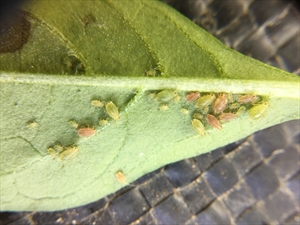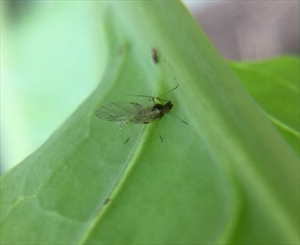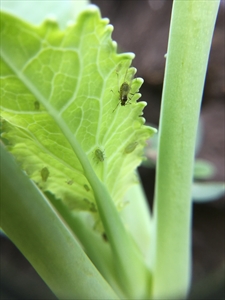Green peach aphid
Pacific Pests, Pathogens, Weeds & Pesticides - Online edition
Pacific Pests, Pathogens, Weeds & Pesticides
Green peach aphid (350)
Myzus persicae
Asia, Africa, North, South and Central America, the Caribbean, Europe, Oceania. It is recorded from Australia, Fiji1, New Caledonia, New Zealand, Northern Mariana Islands, Solomon Islands, and Tonga.
Wide. Over 40 families are hosts. Peach, nectarine, plum and almond are the main hosts, but there are many vegetables, too: bean, cabbage, capsicum, lettuce, papaya, pea, peach, potato, sweet potato, and ornamentals as well as weeds [(e.g., dock (Rumex), sowthistle (Sonchus), lambsquarters (Chenopodium) and pigweed (Portulaca)].
Adults and nymphs do the damage in three ways: first, they feed directly on young tender plant tissues, often drying out shoots, causing wilts and distortions; second, they produce honeydew which falls onto foliage and becomes blackened by sooty mould fungi; and third, they spread more than 100 viruses. However, although the importance of the aphid as a virus vector is well known in other parts of the world, very little is known about the aphid and its potential to spread viruses in Pacific island countries.
Adults are about 2 mm long, greenish-yellow, sometimes with a brown tinge (Photo 1-3). Adults may be winged or wingless. If winged, then the head and thorax - i.e., the segment that bears the first pair of legs - is black (Photos 4&5). The nymphs are similar to the wingless adults, except in size.
In tropical countries, males do not exist. Females give birth to living young without fertilisation. There are about 20 generations of the aphid per year. The average life cycle is about 18 days.
Spread occurs by the winged forms of the aphid, and also long distance in wind and storms. Spread also occurs associated with the international movement of plants and plant parts for food and propagation.
The impact of this aphid is that it spreads many important viruses. Some are 'persistent' in that they multiply within the aphid and are spread during feeding for as long as the aphid lives; others are 'non-persistent', do not multiply within the aphid and are lost quickly during feeding.
Some of the damaging viruses are potato leafroll, potato Y, beet western yellows, beet yellows, cauliflower mosaic, cucumber mosaic, lettuce mosaic, papaya ringspot, turnip mosaic, and watermelon mosaic. The green peach aphid is considered the most important vector of plant viruses in the world.
Look for the greenish-yellow aphids, tinged with brown, and the dark first segment on those with wings. However, in commercial crops, it is the presence of virus that is important, far more than the physical damage of the aphids. For this reason, aphids are trapped and tested for viruses.
NATURAL ENEMIES
Aphid predators and parasites usually keep populations low. The most common are ladybird beetles (adults and larvae), syrphid fly larvae, green lacewing larvae, and tiny parasitic wasps that lay their eggs in the aphids. The wasp larvae develop in the aphids eating the inside parts and turning the aphids into empty shells called 'mummies'. There are many parasitoids attacking the green peach aphid with, perhaps, species of Aphidius and Aphelinus, the most important. However, it is often the case that low aphid populations can still cause high virus incidence.
CULTURAL CONTROL
Most of the cultural control methods are aimed at controlling the viruses spread by the green peach aphid.
Before planting:
- Control weeds in and around the nursery to prevent infestation of young plants by aphids or their infection by viruses.
- Do not plant down-wind from crops with aphids. Some aphids have wings, but they are not strong fliers, and are more likely to be blown in the wind onto new crops.
- Use virus-tested certified seed for e.g., potatoes and beans, and other legumes.
- Remove volunteer plants (i.e., plants unharvested from the previous crop) that might serve as a source of infection for the new crop.
- Growing flowering plants with cabbage and other vegetables may be useful to attract syrphids.
During growth:
- Remove weeds from within and outside the crop.
- Inspect crops often and regularly; destroy leaves heavily infested with aphids by hand (or if necessary use insecticides - see below).
- Inspect crops of e.g., potato and rogue (remove) infected plants, and possibly those adjacent.
- Mulch the crop. With some mulches (e.g. aluminium foil and white plastic), aphids find it more difficult to distinguish the crop plants from bare ground; this method is expensive, however. Row covers over seedlings can also be tried, depending on the value of the crop.
- If ants are present, find the nest, and if not too close to the crop plants with aphids, destroy the nest with boiling water. Without ants, predators and parasites may bring about natural control.
After harvest:
- Collect, burn or bury the remains of crops after harvest.
CHEMICAL CONTROL
The green peach aphid is important mainly because it spreads viruses. This means that populations of aphids need to be kept very low, and that is difficult. It is particularly difficult to prevent aphids from spreading non-persistent viruses because they are spread very quickly. By the time the aphid has been killed by the pesticide, it has fed and infected the plant. Furthermore, aphids may be passing through the crop, checking the plants as hosts and in the process spreading viruses, and then moving on.
Where the aphids require time to acquire and spread viruses (persistent viruses), the use of insecticides can be useful. But note, that this aphid has shown an ability to produce populations tolerant to several insecticide groups, including organophosphates and pyrethroids.
- If necessary to use an insecticide, use white oil (made from vegetable oils), soap solution, or horticultural oil (made from petroleum) (see Fact Sheet no. 56).
- White oil:
- 3 tablespoons (1/3 cup) cooking oil in 4 litres water
- ½ teaspoon pure hand soap, not detergent
- Shake well and use.
- Soap:
- Use soap (pure soap, not detergent):
- 5 tablespoons of soap in 4 litres water.
- White oil:
- Commercial horticultural oil can also be used. White oil, soap and horticultural oil sprays work by blocking the breathing holes of insects causing suffocation and death. Spray the undersides of leaves; the oils must contact the insects. A second application of soap or oils may be necessary after 3-4 weeks. Home-made preparations are ideal for small numbers of plants, but commercial products are probably the only practical solution when crop areas are large.
Alternatively, use:
-
Plant-derived products, such as neem, derris, pyrethrum and chilli (with the addition of soap). (See Fact Sheet no. 56.)
- Synthetic pyrethroid insecticides are likely to be effective (unless there are tolerant populations), but they are likely to kill natural enemies. They are best avoided, if possible. However, they can be used to kill ants, which often tend aphids for their honeydew, and protect them from effective control by predators and parasitoids.
--------------------
Note, derris (Derris species) contains rotenone, an insecticide, often used as a fish poison; it should be used with caution. The commercial derris insecticide is made from Derris elliptica.
____________________
When using a pesticide, always wear protective clothing and follow the instructions on the product label, such as dosage, timing of application, and pre-harvest interval. Recommendations will vary with the crop and system of cultivation. Expert advice on the most appropriate pesticide to use should always be sought from local agricultural authorities.
AUTHOR Grahame Jackson
1Information from Swaine G (1971) Agricultural Zoology in Fiji. Her Majesty's Stationery Office. London; and CABI (2016) Myzus persicae (green peach aphid) Crop Protection Compendium (https://www.cabi.org/cpc/datasheet/35642); and Waterhouse DE, Sands DPA (2001) Classical biological control of arthropods in Australia, ACIAR Monograph no. 77, 560pp.; and from Capinera JL (2020) Myzus persicae (Sulzer). Featured Creatures. Entomology & Nematology. UF/IFAS, University of Florida. (http://entnemdept.ufl.edu/creatures/veg/aphid/green_peach_aphid.htm). Photos 1-6 Mani Mua, Sigatoka Research Station, Fiji.
Produced with support from the Australian Centre for International Agricultural Research under project PC/2010/090: Strengthening integrated crop management research in the Pacific Islands in support of sustainable intensification of high-value crop production, implemented by the University of Queensland and the Secretariat of the Pacific Community.








